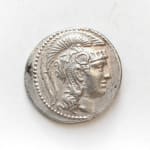Athenian Silver Tetradrachm in the New Style, 177 BCE
Silver
height 2.9 cm
height 1 1/8 in
height 1 1/8 in
C.6109
Obverse, head of Athena wearing Athenian helmet in right profile; pellet border, encircling; reverse, owl facing right and standing on an amphora marked with the letter Lambda, on the left...
Obverse, head of Athena wearing Athenian helmet in right profile; pellet border, encircling; reverse, owl facing right and standing on an amphora marked with the letter Lambda, on the left small Asklepios; on the two sides of the owl letters Athe[naion] and the names of the two coin magistrates, Mened[emos] and Epigeno[s], all within laurel-wreath.
The tetradrachm – a silver coin equivalent to four drachmae – first came into circulation in Athens in 510 BC, replacing the earlier “heraldic” type of currency. The tetradrachm was to become the most authoritative coinage of Classical Greece and was adopted by many other city-states. It would remain barely changed over the next three centuries.
By 2nd century BCE Athens’ fortunes had waned, conquered first by Sparta and then Macedonia. Shifts in the Socio-economic and political landscape give rise to a new-style of coinage, showing Athena wearing a crested helmet on the obverse and a highly-stylized owl standing upon a prostrate amphora on the reverse. This issue, which was minted almost four hundred years after the first tetradrachms marks the changes to a very distinct iconography that would endure until the Roman conquest.
Bibl.: Sundwall, J. 1907, Untersuchungen Ueber die Attische Muenzen des Neueren Stiles, Helsingfors, p. 93.
The tetradrachm – a silver coin equivalent to four drachmae – first came into circulation in Athens in 510 BC, replacing the earlier “heraldic” type of currency. The tetradrachm was to become the most authoritative coinage of Classical Greece and was adopted by many other city-states. It would remain barely changed over the next three centuries.
By 2nd century BCE Athens’ fortunes had waned, conquered first by Sparta and then Macedonia. Shifts in the Socio-economic and political landscape give rise to a new-style of coinage, showing Athena wearing a crested helmet on the obverse and a highly-stylized owl standing upon a prostrate amphora on the reverse. This issue, which was minted almost four hundred years after the first tetradrachms marks the changes to a very distinct iconography that would endure until the Roman conquest.
Bibl.: Sundwall, J. 1907, Untersuchungen Ueber die Attische Muenzen des Neueren Stiles, Helsingfors, p. 93.



